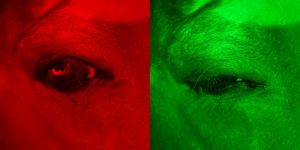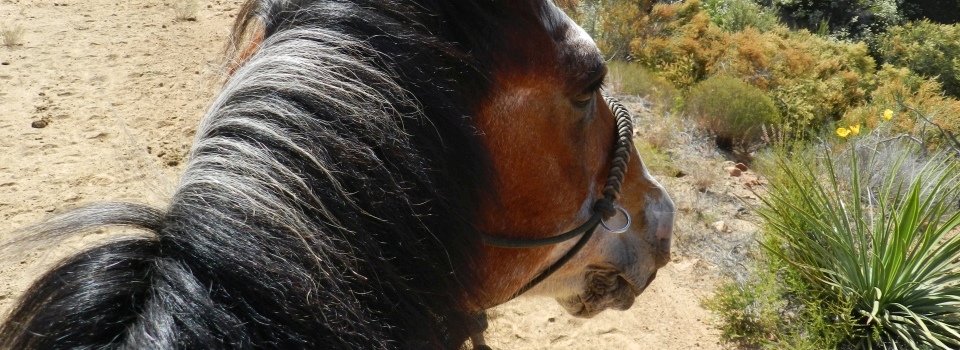Horses see a different world than we do, in large part because of specific differences in their eyes. This article will focus on one aspect, the way horse and human eyes react to the colors of illumination used for enhancing human night vision. If you’re not interested in the details, you can skip straight to the recommendations.
Like humans, horses have two types of light-sensitive cells in their retinas (the retina is the light-sensitive layer at the back of the eye). Rods are sensitive to very low levels of light, but don’t discriminate colors. Cones do the color discrimination, but need more light than rods to do their job. In humans, rods are about a hundred times more light-sensitive than cones, and there’s no reason to expect horses to be any different. Vision involving the cones is called photopic vision and vision involving the rods is scotopic vision.
Photopic vision (colors)
Humans have three different types of cone cells that absorb light of three different wavelengths: 420 nm (nanometers), which appears blue, 534 nm, which appears green, and 564 nm, which appears red. These are “peak sensitivities”; each type of cone detects wavelengths shorter and longer than its peak, and there’s some overlap. We have “trichromatic vision”, and all the different colors we perceive are the result of our brains processing the signals from these blue, green, and red cones.
Humans and other primates are unique among mammals in having trichromatic vision. Horses, dogs, and other mammals have only two kinds of cone cells, and dichromatic vision. In horses, blue-sensitive cones are most absorptive at 428 nm, and the other type of cone is sensitive at 539 nm, which appears yellow-green to us. Some humans have protanopia, a type of color-blindness in which the red cones don’t function; a horse sees the world much like that.
Important for our purposes here, the yellow-green cone can’t detect light with a longer wavelength than around 640 nm, which is a deep red.
Scotopic vision (“night vision”)
Horses have exceptional night vision relative to humans. Their eyes are larger than most other land mammals, to gather more light. They have a tapetum layer that reflects light back onto the retina (this is what causes eyeshine). And their retinas are richer in rods. In environments with moonlight, starlight, or even reflected city lights, horses can see well enough to walk, trot, or even gallop without running into things.
When a rod absorbs light, its visual pigment (rhodopsin, or “visual purple” in older references) is irreversibly changed (“bleached”), so that the cell’s ability to detect light is reduced until new rhodopsin is synthesized. In low light, rhodopsin is regenerated as fast as it is used, but a burst of bright light can bleach all the rhodopsin in all the rod cells, and it can take thirty minutes or more for the cells to fully regain their ability to function. For reasons that are not entirely clear to me, humans regain a useful level of night vision within five minutes of being exposed to bright light, but horses need the full thirty minutes. The same horse that can run across a pasture under the quarter moon cannot easily discriminate details in a dark horse trailer when asked to enter it from bright daylight.
Illumination for night vision
Humans have poorer night vision than many other animals, and there are situations where it’s advantageous to maintain night vision even in the presence of illumination. There are two different approaches in current use.
The first to be developed was the use of red light. Rod cells are insensitive to red light, so they can stay adapted to low-light conditions even while the red cone cells form images. Red nighttime illumination is still used in aviation and some military settings, and in displays of some electronic devices.
Red light has a couple of disadvantages for this use: it requires a higher brightness, since it relies on photopic vision, and it’s sometimes difficult to discriminate shapes and nearly impossible to discriminate colors.
A newer alternative is to use bluish-green light, at about the peak sensitivity of rod cells. Because this is the light that rods see best, extremely low intensities can improve scotopic vision without destroying dark adaptation. In a sense, it’s like carrying around a full moon.
The effect of these two types of light on horses is totally different. Like humans, horses cannot see red with their rod cells, but they also cannot see it (or see it only dimly if it’s more of an orange-red) with their yellow-green cone cells. A human analogy is an infrared remote for an entertainment system: most people cannot see the beam even if it is shining directly in their eyes. For horses, deep red is “infra-yellow-green”, not really a perceived color at all.

And because horses have more rods, and more sensitive rods, than humans, a low-intensity bluish-green light, barely perceptible to a human, would be much brighter to a horse, and would reduce their night vision.
Recommendations
- Red light preserves both human and horse night vision. Horses only see it dimly if at all, and continue to rely on their superb night vision. It allows humans to perceive shapes and see text and diagrams that would be much less visible with the inferior human night vision, but at the same time preserves that night vision for seeing in areas where the beam is not directed.
- The bluish-green light used for enhancing human night vision is inappropriate for horses. It is only effective for preserving night vision in humans at the lowest level of brightness that a human can usefully perceive, and this is much brighter that the lowest level that a horse can perceive. If the human can see it, the horse’s night vision is already impaired.
- Red headlamps or flashlights are useful for night trail riding; they have no effect on the horse’s night vision, and augment the human’s night vision. The use of white light headlamps or flashlights is strongly discouraged; they destroy night vision in both horses and humans in exchange for providing only a narrow area of illumination, and when they are switched off, horses need much longer to regain night vision than humans, and are effectively stumbling in the dark until they do.
- Red LED illumination may be more useful for barns and outdoor stables than the usual fluorescent lighting. It allows a human to deal with a specific horse without destroying the night vision of all the other horses in the facility. Horses differ in their response to “having the lights turned on”, but even for the most nonreactive horse, it’s one more thing to put up with. In my ideal facility, there would be red light illumination everywhere that would go on with a single switch, so I could walk down the aisle without tripping on something. Each stall could have an individual white flood lamp, or I could carry a white headlamp or flashlight, if I needed better vision for a specific horse.
Executive summary: Red light, yes. Green light, no.

This was very interesting. Now questions:
For riding at night (tail miles or in unlit schooling area) what do I use for a head lamp?
For trailering at night, I normally leave a incandescent light on in the horse area to offset the vehicle lights. What color light is best for the horse area in an open stock trailer that will be ok for the horses but will not distract drivers and increase the chance of accidents?
In answer to your first question, a lot of LED headlamps include a red setting (mine cycles through red, bright white, very bright white, and annoyingly blinking white). But the red setting is often not very bright, and is only useful at close range. I bought an extremely bright red LED flashlight that works well, and I’m hoping to someday track down a red headlamp that bright.
In answer to your second question, I was just talking to a friend about that yesterday; I had never really thought about the issue of vehicle lights in a trailer. The problem is that vehicle lights will mess up their night vision, leaving them in the dark for the rest of the time, and there’s no way to control that. Since no one makes red goggles or transparent red fly masks for horses ?, I think the best approach is to use a bright enough light to give them photopic vision during the times when they’re not illuminated by headlights. As far as not distracting other drivers, it occurs to me that amber might be a good color, since the side running lights are often amber.
If the horses are unloaded into a lighted area (which is pretty ordinary) and stalled for the rest of the night, they should have no problems. But if they need to work in the dark after they come off the trailer, they’ll need 30 minutes to adapt.
Thank you for your kind words about my pages and for including me in your links.